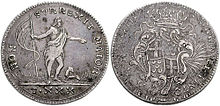
Manfred was the last King of Sicily from the Hohenstaufen dynasty, reigning from 1258 until his death. The natural son of the Holy Roman Emperor Frederick II, Manfred became regent over the kingdom of Sicily on behalf of his nephew Conradin in 1254. As regent he subdued rebellions in the kingdom, until in 1258 he usurped Conradin's rule. After an initial attempt to appease Pope Innocent IV he took up the ongoing conflict between the Hohenstaufens and the papacy through combat and political alliances. He defeated the papal army at Foggia on 2 December 1254. Excommunicated by three successive popes, Manfred was the target of a Crusade (1255–66) called first by Pope Alexander IV and then by Urban IV. Nothing came of Alexander's call, but Urban enlisted the aid of Charles of Anjou in overthrowing Manfred. Manfred was killed during his defeat by Charles at the Battle of Benevento, and Charles assumed kingship of Sicily.

The Kingdom of Naples, also known as the Kingdom of Sicily, was a state that ruled the part of the Italian Peninsula south of the Papal States between 1282 and 1816. It was established by the War of the Sicilian Vespers (1282–1302), when the island of Sicily revolted and was conquered by the Crown of Aragon, becoming a separate kingdom also called the Kingdom of Sicily. This left the Neapolitan mainland under the possession of Charles of Anjou. Later, two competing lines of the Angevin family competed for the Kingdom of Naples in the late 14th century, which resulted in the death of Joan I by Charles III of Naples. Charles' daughter Joanna II adopted King Alfonso V of Aragon as heir, who would then unite Naples into his Aragonese dominions in 1442.

The Kingdom of Sicily was a state that existed in the south of the Italian Peninsula and for a time the region of Ifriqiya from its founding by Roger II of Sicily in 1130 until 1816. It was a successor state of the County of Sicily, which had been founded in 1071 during the Norman conquest of the southern peninsula. The island was divided into three regions: Val di Mazara, Val Demone and Val di Noto.

The lira was the currency of Italy between 1861 and 2002. It was introduced by the Napoleonic Kingdom of Italy in 1807 at par with the French franc, and was subsequently adopted by the different states that would eventually form the Kingdom of Italy in 1861. It was subdivided into 100 centesimi, which means "hundredths" or "cents". The lira was also the currency of the Albanian Kingdom from 1941 to 1943.
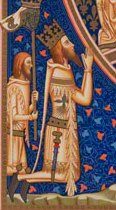
Louis I, also known as Louis of Taranto, was a member of the Capetian House of Anjou who reigned as King of Naples, Count of Provence and Forcalquier, and Prince of Taranto.
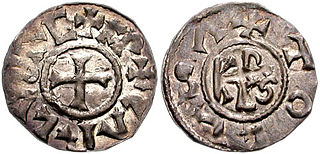
The denier or penny was a medieval coin which takes its name from the Frankish coin first issued in the late seventh century; in English it is sometimes referred to as a silver penny. Its appearance represents the end of gold coinage, which, at the start of Frankish rule, had either been Roman (Byzantine) or "pseudo-imperial". Silver would be the basis for Frankish coinage from then on. The denier was minted in France, Cyprus and parts of the Italian peninsula for the whole of the Middle Ages, in states such as the patriarchate of Aquileia, the Kingdom of Sicily, the Republic of Genoa, the Republic of Siena, Kingdom of Cyprus, and the crusader state Kingdom of Jerusalem, among others.
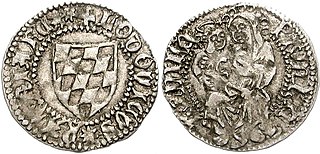
The soldo was an Italian medieval silver coin, issued for the first time in the late 12th century at Milan by Emperor Henry VI. The name derives from the late Roman coin solidus.

The scudo is the official currency of the Sovereign Military Order of Malta and was the currency of Malta during the rule of the Order over Malta, which ended in 1798. It is subdivided into 12 tarì, each of 20 grani with 6 piccoli to the grano. It is pegged to the euro.

The Duchy of Amalfi or the Republic of Amalfi was a de facto independent state centered on the Southern Italian city of Amalfi during the 10th and 11th centuries. The city and its territory were originally part of the larger ducatus Neapolitanus, governed by a patrician, but it extracted itself from Byzantine vassalage and first elected a duke in 958.

The piastra was the distinct currency of the Kingdom of Sicily until 1815.
Richard III, also known as Richard of Caleno, was the Norman count of Carinola and last quasi-independent Duke of Gaeta, ruling from 1121 to his death. From 1113, he was regent of Gaeta for his cousin or nephew, Duke Jonathan; in 1121 he succeeded him. As duke he was a nominal vassal of the Princes of Capua, to whom he was related.
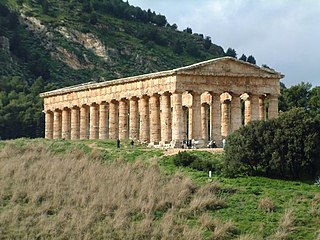
The history of Sicily has been influenced by numerous ethnic groups. It has seen Sicily controlled by powers – Phoenician and Carthaginian, Greek, Roman, Vandal and Ostrogoth, Byzantine Greek, Arab, Norman, Aragonese, Spanish, Austrians, British – but also experiencing important periods of independence, as under the indigenous Sicanians, Elymians, Sicels, the greek-siceliotes, and later as County of Sicily, and Kingdom of Sicily. The Kingdom was founded in 1130 by Roger II, belonging to the Siculo-Norman family of Hauteville. During this period, Sicily was prosperous and politically powerful, becoming one of the wealthiest states in all of Europe. As a result of the dynastic succession, then, the Kingdom passed into the hands of the Hohenstaufen. At the end of the 13th century, with the War of the Sicilian Vespers between the crowns of Anjou and Aragon, the island passed to the latter. In the following centuries the Kingdom entered into the personal union with the Spaniard and Bourbon crowns, while preserving effective independence until 1816. Sicily was merged with the Kingdom of Italy in 1861. Although today an Autonomous Region, with special statute, of the Republic of Italy, it has its own distinct culture.
The Venetian grosso is a silver coin first introduced in Venice in 1193 under doge Enrico Dandolo. It originally weighed 2.18 grams, was composed of 98.5% pure silver, and was valued at 26 denarii. Its name is from the same root as groschen and the English groat, all deriving ultimately from the denaro grosso.

During the High Middle Ages, the Islamic world was at its cultural peak, supplying information and ideas to Europe, via Al-Andalus, Sicily and the Crusader kingdoms in the Levant. These included Latin translations of the Greek Classics and of Arabic texts in astronomy, mathematics, science, and medicine. Translation of Arabic philosophical texts into Latin "led to the transformation of almost all philosophical disciplines in the medieval Latin world", with a particularly strong influence of Muslim philosophers being felt in natural philosophy, psychology and metaphysics. Other contributions included technological and scientific innovations via the Silk Road, including Chinese inventions such as paper, compass and gunpowder.

The term Norman–Arab–Byzantine culture, Norman–Sicilian culture or, less inclusively, Norman–Arab culture, refers to the interaction of the Norman, Byzantine Greek, Latin, and Arab cultures following the Norman conquest of the former Emirate of Sicily and North Africa from 1061 to around 1250. The civilization resulted from numerous exchanges in the cultural and scientific fields, based on the tolerance shown by the Normans towards the Latin- and Greek-speaking Christian populations and the former Arab Muslim settlers. As a result, Sicily under the Normans became a crossroad for the interaction between the Norman and Latin Catholic, Byzantine–Orthodox, and Arab–Islamic cultures.
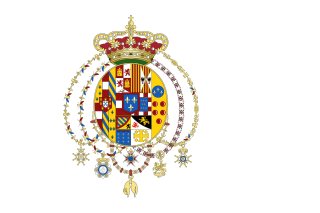
The Kingdom of the Two Sicilies was a kingdom in Southern Italy from 1816 to 1861 under the control of a cadet branch of the Spanish Bourbons. The kingdom was the largest sovereign state by population and size in Italy before Italian unification, comprising Sicily and most of the area of today's Mezzogiorno in covering all of the Italian Peninsula south of the Papal States.

A tarì was the Christian designation of a type of gold coin of Islamic origin minted in Sicily, Malta and Southern Italy from about 913 to the 13th century.

Italy has a long history of different coinage types, which spans thousands of years. Italy has been influential at a coinage point of view: the medieval Florentine florin, one of the most used coinage types in European history and one of the most important coins in Western history, was struck in Florence in the 13th century, while the Venetian sequin, minted from 1284 to 1797, was the most prestigious gold coin in circulation in the commercial centers of the Mediterranean Sea.

The Bolognino was a coin minted in Bologna and other cities of medieval Italy from the late 12th century to the 17th century.

The economy of Scotland in the Middle Ages covers all forms of economic activity in the modern boundaries of Scotland, between the End of Roman rule in Britain in the early fifth century, until the advent of the Renaissance in the early sixteenth century, including agriculture, crafts and trade. Having between a fifth or sixth (15-20 %) of the arable or good pastoral land and roughly the same amount of coastline as England and Wales, marginal pastoral agriculture and fishing were two of the most important aspects of the Medieval Scottish economy. With poor communications, in the early Middle Ages most settlements needed to achieve a degree of self-sufficiency in agriculture. Most farms were operated by a family unit and used an infield and outfield system.
